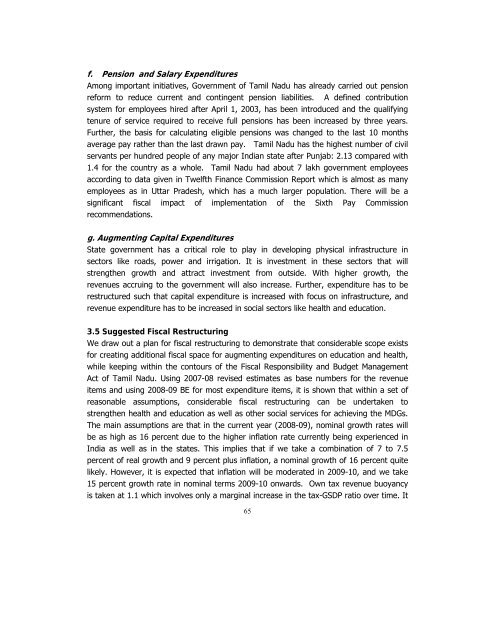POVERTY REDUCTION STRATEGY TN
You also want an ePaper? Increase the reach of your titles
YUMPU automatically turns print PDFs into web optimized ePapers that Google loves.
f. Pension and Salary Expenditures<br />
Among important initiatives, Government of Tamil Nadu has already carried out pension<br />
reform to reduce current and contingent pension liabilities. A defined contribution<br />
system for employees hired after April 1, 2003, has been introduced and the qualifying<br />
tenure of service required to receive full pensions has been increased by three years.<br />
Further, the basis for calculating eligible pensions was changed to the last 10 months<br />
average pay rather than the last drawn pay. Tamil Nadu has the highest number of civil<br />
servants per hundred people of any major Indian state after Punjab: 2.13 compared with<br />
1.4 for the country as a whole. Tamil Nadu had about 7 lakh government employees<br />
according to data given in Twelfth Finance Commission Report which is almost as many<br />
employees as in Uttar Pradesh, which has a much larger population. There will be a<br />
significant fiscal impact of implementation of the Sixth Pay Commission<br />
recommendations.<br />
g. Augmenting Capital Expenditures<br />
State government has a critical role to play in developing physical infrastructure in<br />
sectors like roads, power and irrigation. It is investment in these sectors that will<br />
strengthen growth and attract investment from outside. With higher growth, the<br />
revenues accruing to the government will also increase. Further, expenditure has to be<br />
restructured such that capital expenditure is increased with focus on infrastructure, and<br />
revenue expenditure has to be increased in social sectors like health and education.<br />
3.5 Suggested Fiscal Restructuring<br />
We draw out a plan for fiscal restructuring to demonstrate that considerable scope exists<br />
for creating additional fiscal space for augmenting expenditures on education and health,<br />
while keeping within the contours of the Fiscal Responsibility and Budget Management<br />
Act of Tamil Nadu. Using 2007-08 revised estimates as base numbers for the revenue<br />
items and using 2008-09 BE for most expenditure items, it is shown that within a set of<br />
reasonable assumptions, considerable fiscal restructuring can be undertaken to<br />
strengthen health and education as well as other social services for achieving the MDGs.<br />
The main assumptions are that in the current year (2008-09), nominal growth rates will<br />
be as high as 16 percent due to the higher inflation rate currently being experienced in<br />
India as well as in the states. This implies that if we take a combination of 7 to 7.5<br />
percent of real growth and 9 percent plus inflation, a nominal growth of 16 percent quite<br />
likely. However, it is expected that inflation will be moderated in 2009-10, and we take<br />
15 percent growth rate in nominal terms 2009-10 onwards. Own tax revenue buoyancy<br />
is taken at 1.1 which involves only a marginal increase in the tax-GSDP ratio over time. It<br />
65

















